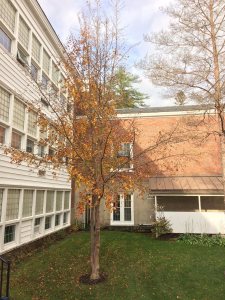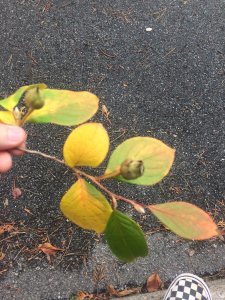Stewartia
Stewartia pseudocamellia | Family: Theaceae
Submission: Eli Nixon ‘19
Japanese stewartia (Stewartia pseudocamellia) can be found ranging across the United States from Washington to Maine, dipping as far south as Northern Texas and as far north as the Washington-Canadian border. Generally a small to medium-sized tree, Japanese stewartia is capable of reaching 40 feet in height. Japanese stewartia grows best in acidic soil rich in organic matter, but is a hardy tree that can grow across a variety of site conditions. Japanese stewartia is extremely shade-tolerant, allowing it to grow well in moderately-shaded sites.
Japanese stewartia, originally from Japan, was introduced to the United States and is now popular with landscape artists due to its attractive year-round appearance. Its flaky bark creates a splotched, nearly camouflage look that is a mix of speckled orange, grey, and brown, which makes the tree recognizable almost immediately, even in the winter. Japanese stewartia produces 2-3″, white, five-petaled flowers in the early summer. The flowers bloom much later than other popular ornamental trees of its size, visually setting it apart in a landscape. In autumn, stewartia leaves turn to vibrant reds, oranges, and purples. This year-round showiness often earns the tree plots anywhere from college campuses to private backyards.
Maintenance of the stewartia is relatively minimal after planting. Naturally it will grow mulitiple stems, which is sometimes favored for its hedge appearance. However, it will often be pruned to allow for a clearer view of the trunk. Beyond pruning, caretakers have little to worry about, as there are few predators which threaten the tree. Deer even dislike the taste of the leaves.
Leaves – Deciduous, simple, alternate leaves, with obovate (ovate with the more narrow end at the base) shape and serrulate (forward facing finely toothed) margins, ranging 2-4” long and deep green in color that turns a mix of purple, yellow, and red in fall.
Twigs – Slender, light reddish brown
Buds – Flattened, divergent bud
Fruit – 1-3” long, 5 parted, oval to round with sharp point, dry woody capsule, produces a large floral bud
Bark – Thin and flaky, color is a mottled mix of reddish browns, oranges and greys
References:
Missouri Botanical Garden online. Np. St. Louis, MO: Stewartia pseudocamellia. [accessed October 14, 2017]. http://www.missouribotanicalgarden.org/.
Seiler J, Jensen E, Niemiera A, Peterson J. 2017. Stewartia Theaceae Stewartia spp. Virginia Tech Dept. of Forest Resources and Environmental Conservation.
U.S. Forest Service. Gilman E, Watson D. Stewartia pseudocamellia Japanese Stewartia. Washington: Government Printing Office, October 1994. (Fact Sheet ST-603).

